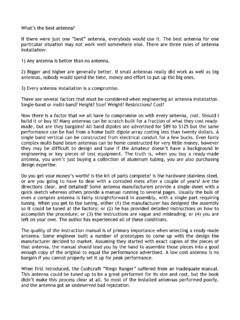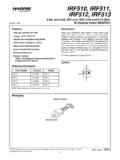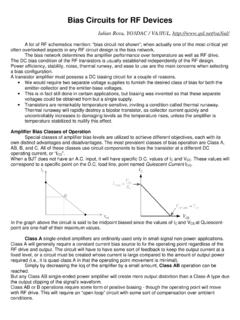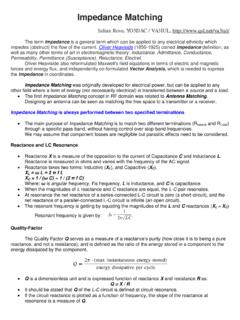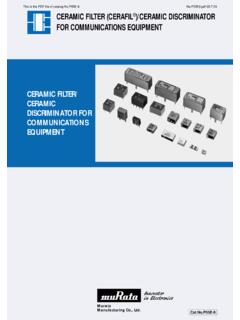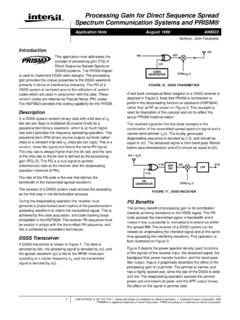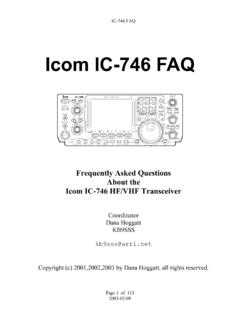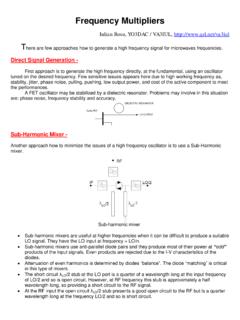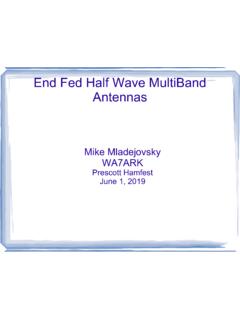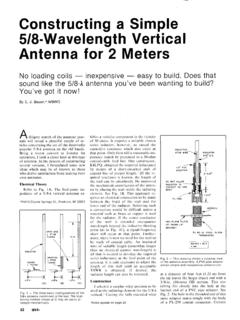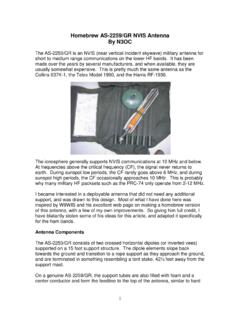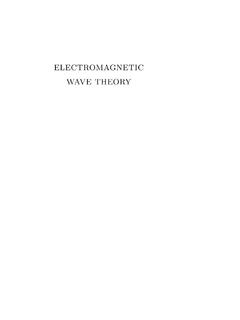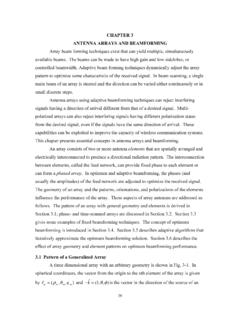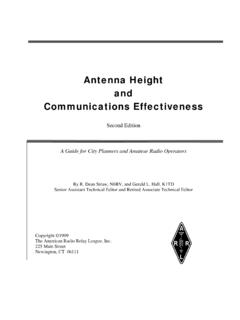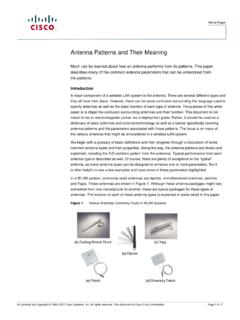Transcription of Antennas & Projects 20 - QSL.net
1 Antennas & BASICS very ham needs at least one antenna , and most hams have built one. This chapter, by ChuckHutchinson, K8CH, covers theory and construction of Antennas for most radio amateurs. Hereyou ll find simple verticals and dipoles, as well as quad and Yagi Projects and other Antennas thatyou can build and amount of available space should be high on the list of factors to consider when selecting anantenna. Those who live in urban areas often must accept a compromise antenna for the HF bandsbecause a city lot won t accommodate full-size wire dipoles, end-fed systems or high supporting struc-tures. Other limitations are imposed by the amount of money available for an antenna system (includingsupporting hardware), the number of amateur bands to be worked and local zoning objectives also come into play.
2 Do you want to dedicate yourself to serious contesting andDXing? Are you looking for general-purpose operation that will yield short- and long-haul QSOs duringperiods of good propagation? Your answers should result in selecting an antenna that will meet yourneeds. You might want to erect the biggest and best collection of Antennas that space and finances willallow. If a modest system is the order of the day, then use whatever is practical and accept the perfor-mance that follows. Practically any radiator works well under some propagation conditions, assumingthe radiator is able to accept power and radiate it at some useful angle. Any antenna is a good one if itmeets your needs!In general, the height of the antenna above ground is the most critical factor at the higher end of theHF spectrum, that is from roughly 14 through 30 MHz.
3 This is because the antenna should be clear ofconductive objects such as power lines, phone wires, gutters and the like, plus high enough to have a lowradiation angle. Lower frequency Antennas , operating between 2 and 10 MHz, should also be kept wellaway from conductive objects and as high above ground as possible if you want good PolarizationMost HF-band Antennas are either vertically or horizontally polarized, although circular polarizationis possible, just as it is at VHF and UHF. Polarization is determined by the position of the radiatingelement or wire with respect to the earth. Thus a radiator that is parallel to the earth radiates horizontally,while an antenna at a right angle to the earth (vertical) radiates a vertical wave. If a wire antenna is slantedabove earth, it radiates waves that have both a vertical and a horizontal & 20 For best results in line-of-sight communications, Antennas at both ends of the circuit should have thesame polarization; cross polarization results in many decibels of signal reduction.
4 It is not essential forboth stations to use the same antenna polarity for ionospheric propagation (sky wave). This is becausethe radiated wave is bent and it tumbles considerably during its travel through the ionosphere. At the farend of the communications path the wave may be horizontal, vertical or somewhere in between at anygiven instant. On multihop transmissions, in which the signal is refracted more than once from theionosophere, and subsequently reflected from the Earth s surface during its travel, considerable polar-ization shift will occur. For that reason, the main consideration for a good DX antenna is a low angleof radiation rather than the BandwidthThe bandwidth of an antenna refers generally to the range of frequencies over which the antenna canbe used to obtain good performance.
5 The bandwidth is often referenced to some SWR value, such as, The 2:1 SWR bandwidth is to MHz. Popular amateur usage of the term bandwidth most oftenrefers to the 2:1 SWR bandwidth. Other specific bandwidth terms are also used, such as the gainbandwidth and the front-to-back ratio the most part, the lower the operating frequency of a given antenna design, the narrower is thebandwidth. This follows the rule that the bandwidth of a resonant circuit doubles as the frequency ofoperation is doubled, assuming the Q is the same for each case. Therefore, it is often difficult to coverall of the 160 or 80-m band for a particular level of SWR with a dipole antenna . It is important torecognize that SWR bandwidth does not always relate directly to gain bandwidth.
6 Depending on theamount of feed-line loss, an 80-m dipole with a relatively narrow 2:1 SWR bandwidth can still radiatea good signal at each end of the band, provided that an antenna tuner is used to allow the transmitter toload properly. Broadbanding techniques, such as fanning the far ends of a dipole to simulate a conicaltype of dipole, can help broaden the SWR response and Voltage DistributionWhen power is fed to an antenna , the current and voltage vary along its length. The current is nearlyzero (a current node) at the ends. The current does not actually reach zero at the current nodes, becauseof capacitance at the antenna ends. Insulators, loops at the antenna ends, and support wires all contributeto this capacitance, which is also called the end effect.
7 In the case of a half-wave antenna there is acurrent maximum (a current loop) at the opposite is true of the RF voltage. That is, there is a voltage loop at the ends, and in the case ofa half-wave antenna there is a voltage minimum (node) at the center. The voltage is not zero at its nodebecause of the resistance of the antenna , which consists of both the RF resistance of the wire (ohmic lossresistance) and the radiation resistance. The radiation resistance is the equivalent resistance that woulddissipate the power the antenna radiates, with a current flowing in it equal to the antenna current at acurrent loop (maximum). The loss resistance of a half-wave antenna is ordinarily small, compared withthe radiation resistance, and can usually be neglected for practical impedance at a given point in the antenna is determined by the ratio of the voltage to the currentat that point.
8 For example, if there were 100 V and A of RF current at a specified point in an antennaand if they were in phase, the impedance would be approximately 71 . antenna impedance may be either resistive or complex (that is, containing resistance and reactance).This will depend on whether or not the antenna is resonant at the operating frequency. You need to knowthe impedance in order to match the feeder to the feedpoint. Some operators mistakenly believe that amismatch, however small, is a serious matter. This is not true. The importance of a matched line isAntennas & in detail in the Transmission Lines chapter of this book. The significance of a perfect matchbecomes more pronounced only at VHF and higher, where feed-line losses are a major Antennas possess a theoretical input impedance at the feedpoint close to that of certain trans-mission lines.
9 For example, a (or half-wave) center-fed dipole, placed at a correct height aboveground, will have a feedpoint impedance of approximately 75 . In such a case it is practical to use a75- coaxial or balanced line to feed the antenna . But few amateur half-wave dipoles actually exhibita 75- impedance. This is because at the lower end of the high-frequency spectrum the typical heightabove ground is rarely more than 1/4 . The 75- feed-point impedance is most likely to be realized ina practical installation when the horizontal dipole is approximately 1/2, 3/4 or 1 wavelength aboveground. Coax cable having a 50- characteristic impedance is the most common transmission line usedin amateur shows the difference between the effects of perfectground and typical earth at low antenna heights.
10 The effect ofheight on the radiation resistance of a horizontal half-wave an-tenna is not drastic so long as the height of the antenna is greaterthan . Below this height, while decreasing rapidly to zeroover perfectly conducting ground, the resistance decreases lessrapidly with height over actual ground. At lower heights the resis-tance stops decreasing at around , and thereafter increasesas height decreases further. The reason for the increasing resis-tance is that more and more of the induction field of the antennais absorbed by the earth as the height drops below 1/4 .Conductor SizeThe impedance of the antenna also depends on the diameter ofthe conductor in relation to the wavelength, as indicated inFig If the diameter of the conductor is increased, the capaci-tance per unit length increases and the inductance per unit lengthdecreases.

